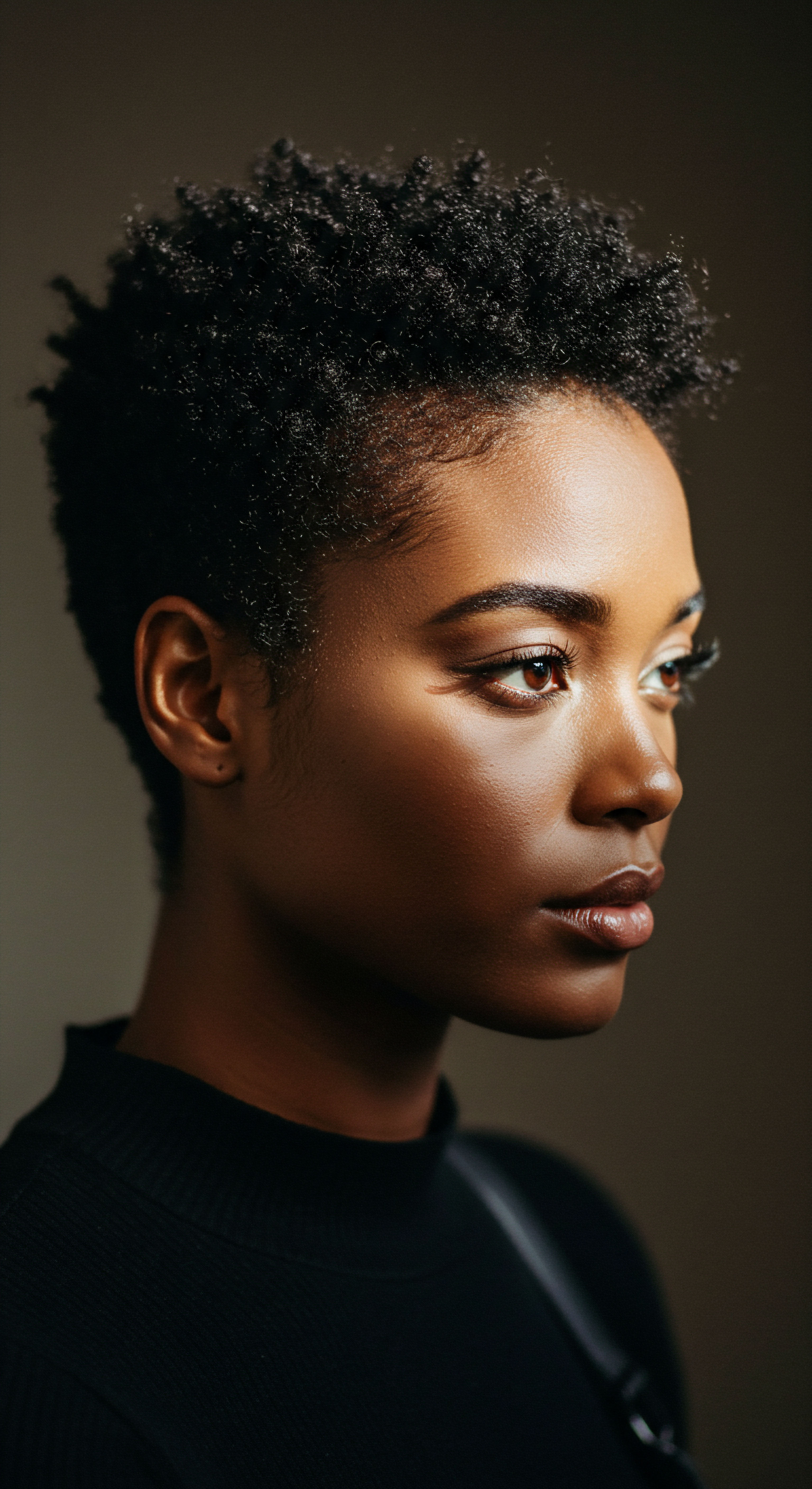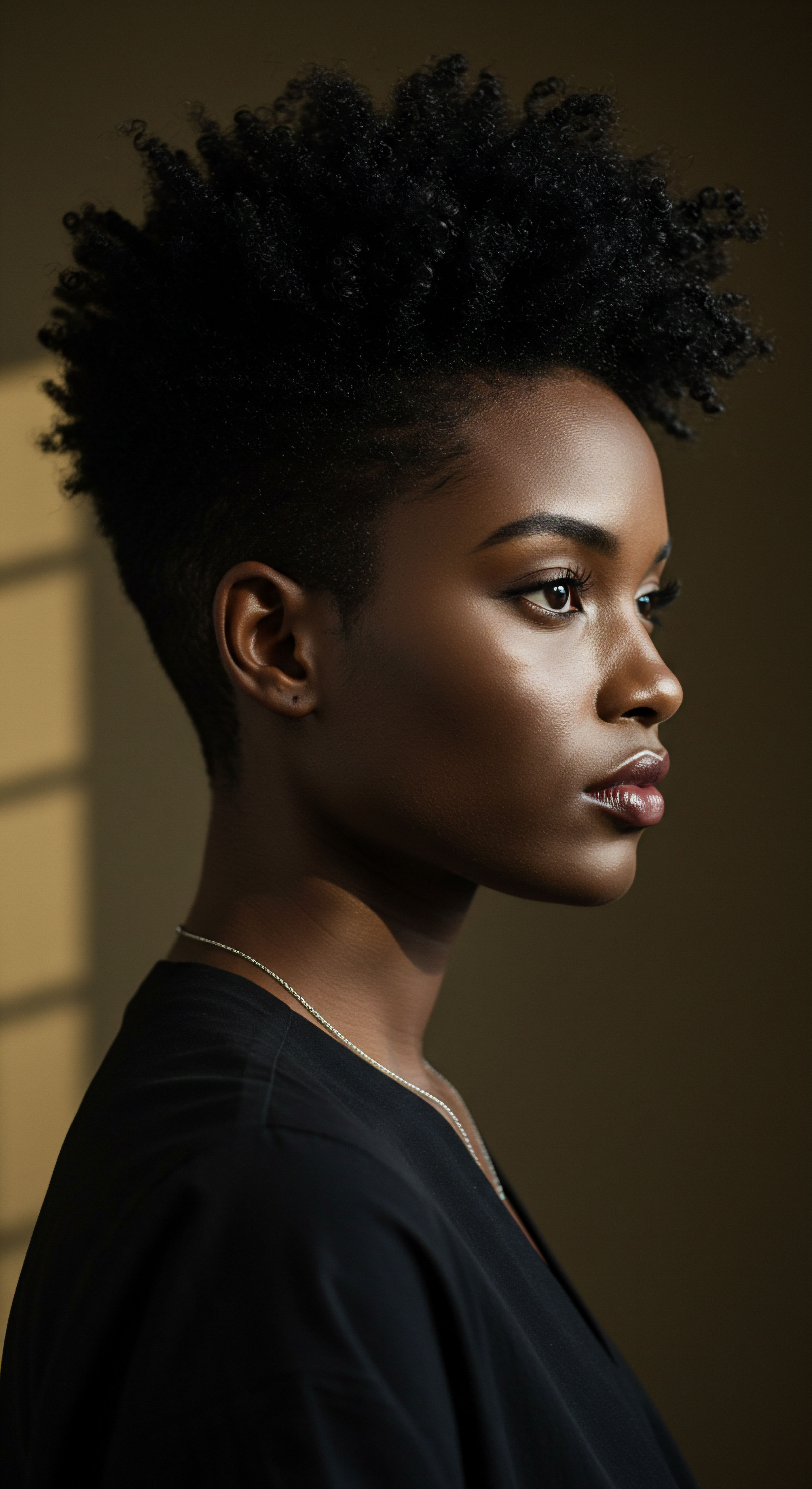
Roots
Consider for a moment the quiet strength that resides within each strand, a story held not only in its curl and coil but also in the very foundations of its being. We often admire the outward display of vibrant, textured hair, yet its true vitality springs from an unseen realm, a deep, intricate connection to our internal rhythm and well-being. Can the consistent cadence of our slumber truly reach into this hidden world, reshaping the very density of our textured crowns? This exploration begins at the cellular heart of hair, a place where biological processes quietly orchestrate its existence.
The journey of hair, from its nascent beginnings to its full expression, is a testament to the body’s remarkable capacity for renewal. Each individual hair emerges from a specialized structure nestled beneath the skin’s surface ❉ the Hair Follicle. These microscopic powerhouses are far more than mere anchors; they are dynamic mini-organs, tirelessly engaged in a cyclical dance of growth, rest, and renewal.
For textured hair, the follicle’s unique shape—often oval or elliptical—plays a significant role in determining the characteristic curl pattern and inherent fragility. This architectural distinction means that textured strands possess a natural tendency towards dryness and can be more susceptible to breakage, making the underlying health of the follicle paramount.
The profound vitality of textured hair is intimately connected to the unseen, cellular foundations of its growth.

Anatomy and Biology of Textured Hair
To truly appreciate the impact of sleep, we must first comprehend the sophisticated architecture of hair. Each strand comprises three principal layers ❉ the Medulla, the innermost core, often absent in finer hair; the Cortex, the substantial middle layer that grants hair its strength, elasticity, and color; and the Cuticle, the outermost protective shield, composed of overlapping, scale-like cells. In textured hair, the cuticle layers tend to lift more readily, contributing to its distinct texture and a greater propensity for moisture loss. The integrity of these layers, particularly the cortex, directly correlates with the perceived density and overall resilience of the hair.
The health of these layers, and indeed the hair as a whole, is directly influenced by the intricate biological processes occurring within the follicle. The hair follicle itself is a complex structure, housing various cell types, including specialized stem cells that drive its continuous regeneration. These stem cells, residing in areas like the bulge, are the architects of new hair, and their activity is profoundly sensitive to systemic signals.

How Hair Cells Grow
Hair growth is a marvel of cellular division and differentiation. At the base of the follicle, within the hair bulb, lies the Dermal Papilla, a small cluster of mesenchymal cells that supply vital nutrients and signals to the rapidly dividing cells of the matrix. These matrix cells are among the fastest proliferating cells in the human body. As they divide and move upward, they undergo keratinization, a process where they produce and accumulate keratin proteins, harden, and ultimately form the hair shaft that emerges from the scalp.
This continuous production of new cells at the follicle’s base is what dictates hair length and, critically, contributes to its perceived density. A consistent, robust production of these cells ensures a healthy, full appearance.
- Keratin ❉ The primary protein making up hair, providing strength and structure.
- Hair Follicle ❉ The mini-organ in the skin from which hair grows.
- Dermal Papilla ❉ Supplies nutrients and signals to the hair-producing cells.

Hair Growth Cycles and Their Internal Regulation
Hair growth is not a constant, uninterrupted process; it proceeds in distinct, cyclical phases. Understanding these phases is fundamental to grasping how sleep might influence hair density.
- Anagen ❉ The active growth phase, lasting from two to seven years. During this period, hair cells rapidly divide, and the hair shaft lengthens. The longer hair remains in anagen, the longer it can grow.
- Catagen ❉ A short, transitional phase, lasting about two to three weeks. Growth ceases, and the follicle shrinks.
- Telogen ❉ The resting phase, lasting around two to four months. During this time, the hair remains in the follicle but is no longer growing. Towards the end of telogen, the old hair is shed to make way for a new anagen hair.
- Exogen ❉ Often considered a part of telogen, this is the active shedding phase where the old hair is released.
At any given moment, approximately 85-90% of a person’s hair is in the anagen phase, while a smaller percentage is in catagen or telogen. The balance between these phases, particularly the length of the anagen phase and the number of follicles in telogen, directly influences the overall density of the hair. When this delicate balance is disturbed, leading to a premature shift of hairs from anagen to telogen, the result is often noticeable thinning or shedding. This foundational understanding sets the stage for exploring how our nightly routines can either support or undermine this natural rhythm.

Ritual
We arrive now at the quiet hours, those moments when the world outside softens and our bodies seek repose. For many, the idea of a nightly routine for hair might conjure images of elaborate braiding or the careful tying of silk scarves. These external practices, while valuable for physical protection, are but one layer of a far deeper influence.
The true ‘ritual’ of sleep, in its most profound sense, extends beyond conscious action, reaching into the very core of our physiological repair and restoration. Can the quality of this nocturnal journey truly alter the very substance of textured hair?
The consistency of our sleep patterns acts as a subtle conductor for a grand biological symphony, one that profoundly impacts hair health and, by extension, its density. It is during these hours of quietude that the body engages in its most vital regenerative work, a process that is as much about what happens within as it is about what we gently apply to our strands. This is where the wisdom of ancient practices, which often connected rest to overall vitality, finds its resonance with contemporary scientific understanding.

The Nighttime Sanctuary for Hair
The physical protection offered by a silk bonnet or pillowcase is a tangible, valuable aspect of nighttime care for textured hair. These smooth surfaces minimize friction, preventing tangles, breakage, and the absorption of precious moisture from the hair shaft. This reduction in mechanical stress is crucial for preserving existing hair density and preventing shedding that might otherwise occur from damage.
Beyond the tangible, the very act of preparing for sleep—a consistent bedtime, a darkened room, a calming transition—sends signals to the body, signaling a time for repair. This ritualistic winding down can significantly lower levels of stress hormones, which, as we will explore, play a significant role in hair cycle disruption.
Beyond physical protection, the very consistency of a nightly routine signals the body to initiate its vital regenerative processes.

Hormonal Regulation During Sleep
Sleep is a critical period for hormonal regulation, and several hormones directly influence hair growth and density. Melatonin, often associated with sleep regulation, also appears to have a direct impact on hair follicles. Studies indicate that melatonin possesses antioxidant properties, safeguarding follicles from cellular damage, and may even stimulate cell growth within the hair follicle itself. Its influence extends to prolonging the Anagen Phase, the active growth stage, allowing hair to grow longer and potentially denser.
Conversely, insufficient sleep can lead to elevated levels of Cortisol, often referred to as the stress hormone. Chronic elevation of cortisol can disrupt the delicate balance of the hair growth cycle, prematurely pushing hair follicles from their active growth phase into a resting or shedding phase. This hormonal imbalance directly contributes to reduced hair density over time.
Growth hormones, essential for cell regeneration throughout the body, including hair follicles, are also primarily synthesized and released during deep sleep. A consistent, quality sleep routine ensures these vital hormones are produced in optimal amounts, supporting robust hair growth.
The regulation of these hormones, orchestrated by a consistent sleep schedule, acts as a profound internal mechanism for maintaining and potentially improving hair density.
| Hormone Melatonin |
| Primary Role in Sleep Regulates sleep-wake cycles |
| Influence on Hair Health Antioxidant, stimulates follicle growth, prolongs anagen phase. |
| Hormone Cortisol |
| Primary Role in Sleep Stress response |
| Influence on Hair Health Elevated levels disrupt hair cycle, trigger shedding. |
| Hormone Growth Hormone |
| Primary Role in Sleep Cell regeneration |
| Influence on Hair Health Essential for hair follicle cell repair and growth. |
| Hormone Balanced hormonal activity during sleep is critical for maintaining hair density. |

Nutrient Delivery and Cellular Repair
During periods of rest, the body prioritizes systemic repair and regeneration. This includes enhanced blood flow to the scalp, which delivers a steady supply of oxygen and vital nutrients directly to the hair follicles. These nutrients—proteins, vitamins, and minerals—are the very building blocks of hair.
Without adequate sleep, this crucial delivery system can be compromised, leading to malnourished follicles that struggle to produce strong, healthy strands. Reduced nutrient supply can result in weaker hair that is more prone to breakage and thinning, directly impacting perceived density.
Cellular turnover and tissue repair also accelerate during sleep. Hair follicles, as sites of rapid cell division, benefit immensely from this nocturnal repair work. The body actively works to mend cellular damage incurred during the day, ensuring that the hair-producing machinery within the follicle remains optimally functional.
This includes the repair of keratinocytes, the cells that form the hair shaft, and the maintenance of stem cell activity. A lack of consistent, restorative sleep hinders these repair processes, potentially leading to cumulative damage that manifests as reduced hair density over time.

Relay
Having considered the foundational biology and the subtle power of nightly rituals, we now consider the deeper, more intricate interplay that truly answers the question ❉ Can consistent sleep routines truly alter the density of textured hair? This requires looking beyond the immediate and embracing the interconnectedness of our physiological systems, recognizing that hair density is not merely a surface phenomenon but a visible manifestation of profound internal equilibrium. Here, science, cultural wisdom, and the quiet resilience of our bodies converge.
The density of textured hair, with its inherent coil and unique structure, is a testament to the follicle’s robust health. Any disruption to the delicate balance within the body can send ripples through this system, potentially impacting the number of active follicles, the thickness of individual strands, and the overall volume of hair. Sleep, far from being a passive state, is an active conductor of these intricate biological processes, acting as a powerful environmental modulator for our hair’s expression.

The Stress-Hair Cycle Connection
One of the most significant pathways through which inconsistent sleep impacts hair density is via the body’s stress response. Chronic sleep deprivation acts as a potent stressor, triggering a sustained elevation of Cortisol. This persistent presence of cortisol is not merely a fleeting inconvenience; it can profoundly disrupt the natural hair growth cycle.
Under chronic stress, a disproportionately high number of hair follicles are prematurely pushed from the active Anagen Phase into the resting Telogen Phase. This condition, known as Telogen Effluvium, results in excessive hair shedding and a noticeable reduction in hair density. Normally, around 10-15% of hair is in the telogen phase at any given time; however, prolonged stress, such as that caused by consistent poor sleep, can increase this percentage dramatically, leading to widespread thinning across the scalp. The body, under perceived threat, diverts resources away from non-essential functions like hair growth, prioritizing survival.
Inconsistent sleep acts as a profound stressor, capable of disrupting the hair growth cycle and reducing overall hair density.

How Does Circadian Rhythm Influence Hair Follicle Activity?
Beyond stress hormones, the body’s internal biological clock, the Circadian Rhythm, exerts a powerful, direct influence on hair follicles. It has been shown that hair follicles themselves possess their own circadian clocks, which regulate gene expression and cellular activity with a roughly 24-hour periodicity. These localized clocks influence various aspects of hair growth, including the timing of cell division within the follicle matrix.
Disruptions to the central circadian rhythm, often caused by inconsistent sleep schedules, shift work, or excessive artificial light exposure at night, can desynchronize these follicular clocks. When the hair follicle’s internal timing is out of sync, its optimal function is compromised. This can lead to less efficient cell proliferation, impaired protein synthesis, and a less robust anagen phase. A study by Plikus et al.
(2013) demonstrated that the local circadian clock in regenerating hair follicles generates a daily mitotic rhythm, causing hairs to grow faster in the morning than in the evening. While this particular study focuses on growth speed, the underlying principle suggests that consistent, aligned circadian rhythms are crucial for the efficient and sustained activity of hair-producing cells, thereby indirectly influencing overall hair density by supporting healthy growth and minimizing premature shedding.
The profound impact of sleep consistency on hair density can be illustrated by considering the broader physiological landscape. Research indicates that sleep deprivation can lead to increased Oxidative Stress within the body. Oxidative stress occurs when there is an imbalance between free radicals and antioxidants, leading to cellular damage. In the context of hair, this damage can directly affect hair follicle cells, impairing their ability to function optimally and produce healthy, dense strands.
Melatonin, produced during sleep, acts as a powerful antioxidant, helping to mitigate this stress. When sleep is inconsistent, melatonin production may be reduced, leaving follicles more vulnerable to oxidative damage.
Furthermore, systemic inflammation, another consequence of chronic poor sleep, can also impact scalp health and hair density. An inflamed scalp environment can hinder proper nutrient delivery to follicles and even contribute to conditions that reduce hair growth.

Does Sleep Deprivation Affect Hair Follicle Stem Cells?
The ability of hair follicles to regenerate throughout life stems from specialized Hair Follicle Stem Cells. These stem cells are crucial for initiating new hair cycles and maintaining density. Emerging research suggests that sleep deprivation can indeed affect the behavior and competence of these vital cells.
A review by Al-Hassany and Al-Abbas (2023) in the Journal of Dermatological Research highlights how sleep deprivation can influence hair follicle stem cells and contribute to telogen effluvium. This implies a direct, albeit complex, link where inconsistent sleep might impair the very machinery responsible for hair regeneration, thereby reducing the potential for new hair growth and ultimately altering density.
Consider the case of a person with textured hair experiencing persistent sleep disturbances. While they might diligently apply nourishing treatments and protective styles, the internal disarray caused by chronic poor sleep could be silently undermining their efforts. The consistent elevation of stress hormones, the desynchronization of follicular circadian clocks, and the increased cellular stress all contribute to a physiological environment less conducive to robust hair growth and maintenance of density. The body’s priorities shift, and hair, as a non-essential tissue for immediate survival, often bears the brunt of this internal imbalance.
| Factor Stress Hormones |
| Mechanism of Impact Elevated cortisol shifts follicles into resting phase. |
| Consequence for Hair Density Increased shedding, reduced active growth. |
| Factor Circadian Rhythm |
| Mechanism of Impact Disrupts follicular clock, impairs cell division. |
| Consequence for Hair Density Less efficient growth, potentially thinner strands. |
| Factor Oxidative Stress |
| Mechanism of Impact Cellular damage to follicles. |
| Consequence for Hair Density Weakened follicles, reduced growth capacity. |
| Factor Stem Cell Activity |
| Mechanism of Impact Impaired regeneration and new hair initiation. |
| Consequence for Hair Density Fewer new hairs, overall thinning. |
| Factor Inconsistent sleep impacts multiple biological pathways that collectively diminish hair density. |
The scientific literature increasingly supports this intricate connection. For instance, a 2018 study published in the Journal of Korean Medical Science found an association between shorter sleep duration and increased hair loss in Korean adults. While not directly measuring density alteration, reduced hair loss directly preserves density.
Furthermore, studies on the effects of melatonin on hair growth, such as a 2021 study by Choi et al. in the Journal of Cosmetic Dermatology (though in mice), indicate that melatonin can promote hair regeneration and affect the hair cycle, suggesting a pathway through which sleep-related hormones can influence hair density.
The conversation around textured hair density often centers on external products and styling techniques. While these are undoubtedly important, the evidence suggests that a truly holistic approach must acknowledge the profound influence of consistent sleep routines. The body’s ability to repair, regenerate, and maintain hormonal equilibrium during sleep is a silent, yet powerful, determinant of hair vitality. Prioritizing consistent, restorative sleep is not merely about feeling rested; it is about nurturing the very biological mechanisms that allow textured hair to flourish in its fullest expression.

Reflection
The journey through the quiet depths of cellular repair and hormonal balance brings us to a compelling realization ❉ the vitality of our textured hair is deeply intertwined with the quality of our rest. It is a testament to the profound connection between our inner physiological landscape and our outward presentation. The quest for dense, thriving strands extends beyond the topical and the visible, reaching into the very rhythms of our nightly slumber.
When we align our routines with the body’s natural need for consistent, restorative sleep, we are not simply resting; we are actively cultivating a fertile ground for hair to flourish. This understanding invites a deeper reverence for our bodies’ inherent wisdom, recognizing that true hair wellness begins long before the sun rises.

References
- Al-Hassany, M. & Al-Abbas, H. (2023). Sleep deprivation and its implications for the hair cycle ❉ a review. Journal of Dermatological Research .
- Montagna, W. & Ellis, R. A. (Eds.). (2013). The Biology of Hair Growth. Elsevier.
- Kwak, J. H. Kim, H. G. & Kim, S. H. (2018). Association between sleep duration and hair loss in Korean adults. Journal of Korean Medical Science .
- Choi, S. Park, J. H. & Kim, S. H. (2021). Effects of sleep deprivation on hair growth and hair loss in mice. Journal of Cosmetic Dermatology .
- Plikus, M. V. Vollmers, C. Cruz, D. de la, Chaix, A. Ramos, R. Panda, S. & Chuong, C-M. (2013). Local circadian clock gates cell cycle progression of transient amplifying cells during regenerative hair cycling. Proceedings of the National Academy of Sciences, 110 (21), E2106-E2115.
- Cotsarelis, G. & Botchkarev, V. (2012). Biology of Hair Follicles. In S. Kang et al. (Eds.), Fitzpatrick’s Dermatology in General Medicine (8th ed.). McGraw-Hill Education.
- Guo, H. & Wang, J. (2020). The role of stress in hair loss. Journal of Dermatology and Cosmetology, 4 (2), 1-5.
- Al-Nuaimi, Y. Hardman, J. A. Bíró, T. Haslam, I. S. Philpott, M. P. Tóth, B. I. & Paus, R. (2014). A meeting of two chronobiological systems ❉ Circadian proteins Period1 and BMAL1 modulate the human hair cycle clock. Journal of Investigative Dermatology, 134 (3), 610-619.
- Paus, R. & Cotsarelis, G. (1999). The biology of hair follicles. The New England Journal of Medicine, 341 (7), 491-497.
- Rushton, D. H. (1993). Hair loss and the human hair cycle. Journal of Investigative Dermatology, 100 (5), 31-35.
- Hardman, J. A. Tobin, D. J. Haslam, I. S. Farjo, N. Farjo, B. Al-Nuaimi, Y. & Paus, R. (2015). The peripheral clock regulates human pigmentation. Journal of Investigative Dermatology, 135 (4), 1053-1064.
- Geyfman, M. & Andersen, B. (2010). Clock genes, hair growth and aging. Aging (Albany NY), 2 (6), 350.
- Watanabe, M. Hida, A. Kitamura, S. Enomoto, M. Ohsawa, Y. Katayose, Y. & Mishima, K. (2012). Rhythmic expression of circadian clock genes in human leukocytes and beard hair follicle cells. Biochemical and Biophysical Research Communications, 425 (4), 902-907.
- Kim, Y. S. & Kim, H. G. (2018). The effect of sleep quality on skin aging in Korean women. Journal of Cosmetic Dermatology, 17 (4), 578-583.
- Saeed, S. & Bashir, M. (2020). The role of sleep in dermatological conditions ❉ a review. Journal of Pakistan Association of Dermatologists, 30 (1), 58-63.